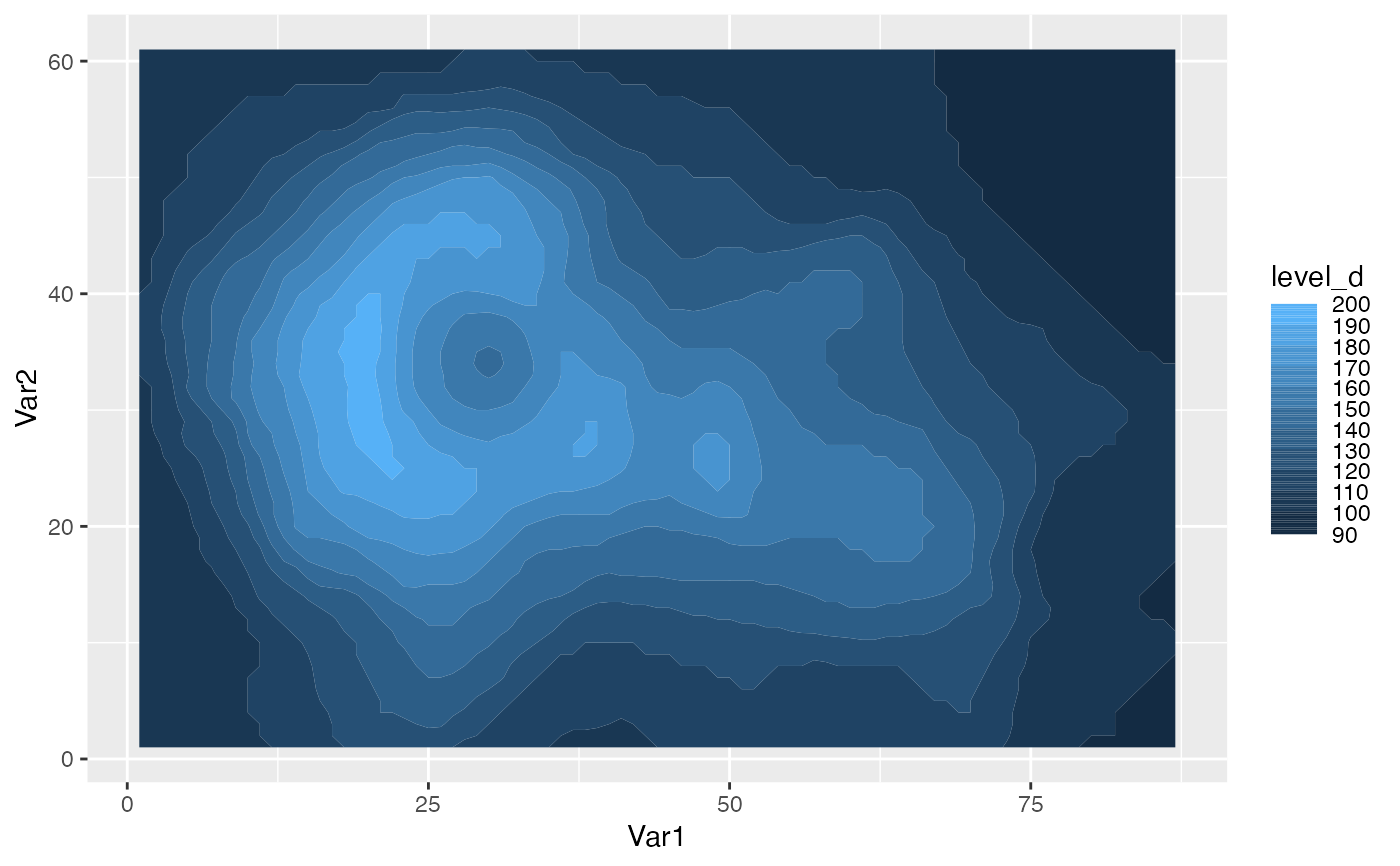Filled 2d contours of a 3d surface
Source:R/geom_contour_fill.R, R/stat_contour_fill.R
geom_contour_fill.RdWhile ggplot2's geom_contour can plot nice contours, it
doesn't work with the polygon geom. This stat makes some small manipulation
of the data to ensure that all contours are closed and also computes a new
aesthetic int.level, which differs from level (computed by
ggplot2::geom_contour) in that represents
the value of the z aesthetic inside the contour instead of at the edge.
It also computes breaks globally instead of per panel, so that faceted plots
have all the same binwidth.
geom_contour_fill(
mapping = NULL,
data = NULL,
stat = "ContourFill",
position = "identity",
...,
breaks = MakeBreaks(),
bins = NULL,
binwidth = NULL,
kriging = FALSE,
global.breaks = TRUE,
na.fill = FALSE,
show.legend = NA,
inherit.aes = TRUE
)
stat_contour_fill(
mapping = NULL,
data = NULL,
geom = "polygon",
position = "identity",
...,
breaks = MakeBreaks(),
bins = NULL,
binwidth = NULL,
global.breaks = TRUE,
kriging = FALSE,
na.fill = FALSE,
show.legend = NA,
inherit.aes = TRUE
)Arguments
- mapping
Set of aesthetic mappings created by
aes(). If specified andinherit.aes = TRUE(the default), it is combined with the default mapping at the top level of the plot. You must supplymappingif there is no plot mapping.- data
The data to be displayed in this layer. There are three options:
If
NULL, the default, the data is inherited from the plot data as specified in the call toggplot().A
data.frame, or other object, will override the plot data. All objects will be fortified to produce a data frame. Seefortify()for which variables will be created.A
functionwill be called with a single argument, the plot data. The return value must be adata.frame, and will be used as the layer data. Afunctioncan be created from aformula(e.g.~ head(.x, 10)).- stat
The statistical transformation to use on the data for this layer, either as a
ggprotoGeomsubclass or as a string naming the stat stripped of thestat_prefix (e.g."count"rather than"stat_count")- position
Position adjustment, either as a string naming the adjustment (e.g.
"jitter"to useposition_jitter), or the result of a call to a position adjustment function. Use the latter if you need to change the settings of the adjustment.- ...
Other arguments passed on to
layer(). These are often aesthetics, used to set an aesthetic to a fixed value, likecolour = "red"orsize = 3. They may also be parameters to the paired geom/stat.- breaks
numeric vector of breaks
- bins
Number of evenly spaced breaks.
- binwidth
Distance between breaks.
- kriging
Logical indicating whether to perform ordinary kriging before contouring. Use this if you want to use contours with irregularly spaced data.
- global.breaks
Logical indicating whether
breaksshould be computed for the whole data or for each grouping.- na.fill
How to fill missing values.
FALSEfor letting the computation fail with no interpolationTRUEfor imputing missing values with Impute2DA numeric value for constant imputation
A function that takes a vector and returns a numeric (e.g.
mean)
- show.legend
logical. Should this layer be included in the legends?
NA, the default, includes if any aesthetics are mapped.FALSEnever includes, andTRUEalways includes. It can also be a named logical vector to finely select the aesthetics to display.- inherit.aes
If
FALSE, overrides the default aesthetics, rather than combining with them. This is most useful for helper functions that define both data and aesthetics and shouldn't inherit behaviour from the default plot specification, e.g.borders().- geom
The geometric object to use to display the data, either as a
ggprotoGeomsubclass or as a string naming the geom stripped of thegeom_prefix (e.g."point"rather than"geom_point")
Aesthetics
geom_contour_fill understands the following aesthetics (required aesthetics are in bold):
x
y
alphacolourgrouplinetypesizeweight
Computed variables
- level
An ordered factor that represents bin ranges.
- level_d
Same as
level, but automatically usesscale_fill_discretised()- level_low,level_high,level_mid
Lower and upper bin boundaries for each band, as well the mid point between the boundaries.
See also
Other ggplot2 helpers:
DivideTimeseries(),
MakeBreaks(),
WrapCircular(),
geom_arrow(),
geom_contour2(),
geom_label_contour(),
geom_relief(),
geom_streamline(),
guide_colourstrip(),
map_labels,
reverselog_trans(),
scale_divergent,
scale_longitude,
stat_na(),
stat_subset()
Examples
library(ggplot2)
surface <- reshape2::melt(volcano)
ggplot(surface, aes(Var1, Var2, z = value)) +
geom_contour_fill() +
geom_contour(color = "black", size = 0.1)
#> Warning: Using `size` aesthetic for lines was deprecated in ggplot2 3.4.0.
#> ℹ Please use `linewidth` instead.
 ggplot(surface, aes(Var1, Var2, z = value)) +
geom_contour_fill(aes(fill = stat(level)))
ggplot(surface, aes(Var1, Var2, z = value)) +
geom_contour_fill(aes(fill = stat(level)))
 ggplot(surface, aes(Var1, Var2, z = value)) +
geom_contour_fill(aes(fill = stat(level_d)))
ggplot(surface, aes(Var1, Var2, z = value)) +
geom_contour_fill(aes(fill = stat(level_d)))
